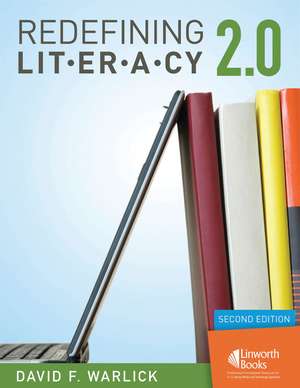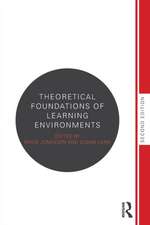Redefining Literacy 2.0
Editat de David F. Warlicken Limba Engleză Paperback – 14 oct 2008 – vârsta până la 17 ani
Preț: 229.32 lei
Preț vechi: 296.31 lei
-23% Nou
Puncte Express: 344
Preț estimativ în valută:
43.88€ • 46.92$ • 36.59£
43.88€ • 46.92$ • 36.59£
Carte tipărită la comandă
Livrare economică 17 aprilie-01 mai
Preluare comenzi: 021 569.72.76
Specificații
ISBN-13: 9781586833336
ISBN-10: 1586833332
Pagini: 128
Dimensiuni: 152 x 229 x 13 mm
Greutate: 0.27 kg
Ediția:2
Editura: Bloomsbury Publishing
Colecția Linworth
Locul publicării:New York, United States
ISBN-10: 1586833332
Pagini: 128
Dimensiuni: 152 x 229 x 13 mm
Greutate: 0.27 kg
Ediția:2
Editura: Bloomsbury Publishing
Colecția Linworth
Locul publicării:New York, United States
Notă biografică
David F. Warlick is the president, consultant, and author with The Landmark Project in Raleigh, NC.
Recenzii
Includes key resources, suggestions for further reading. Very practical. Highly recommended.
Fans of Warlick's first edition of this book titled Redefining Literacy for the 21st Century will be equally impressed with [the] new edition. . . . The rich content of this title coupled with an easy-to-follow, logical format make the book practical and readable. Not only does Warlick wax wisely on his philosophy of 2.0 literacy, he gives readers a jump start in learning how to actually begin the process of teaching students in this environment, in addition to helping them learn to express their ideas 'compellingly' as they text message, create mashups, blog, use wikis, incorporate images, make and edit videos, and other use other 2.0 tools. He also presents important information on ethics and the use of Creative Commons, in addition to providing some 'action items' for educators in various positions, i.e. technology directors, library media specialists, teachers, principals, and others. This title is definitely worth the price for both digital natives, and digital immigrants like many of us in education.
We can expand the traditional 'Three Rs' and build role models for literacy in all classrooms, even in those that are shifting in content and intent on a daily basis, claims consultant Warlick. He describes the opposing forces at work inside and outside the typical public school classroom and exposes the underpinnings of such powerful contenders for students' and teachers' attention as computers and media. He argues for appropriate multimedia electronic resources, methods students can use to solve challenges in constructing information, and techniques of building competency through technology. He presents a day in the life of a 2015 school following his design, showing how students can express ideas compellingly, understand and use complex information, and understand contexts. He also guides educators through planning, implementation and assessment of his system.
In providing new and added dimensions to Literacy 2.0, David Warlick, technology guru, educator, educational consultant, and innovator, presents action plans and ideas for media specialists, school administrators, technology coordinators,teachers, students, and parents. . . . Throughout this guide, numerous features contribute to the text and add to its usefulness, including lists, charts, relevant quotations, suggested additional book titles, and websites for further study.
Fans of Warlick's first edition of this book titled Redefining Literacy for the 21st Century will be equally impressed with [the] new edition. . . . The rich content of this title coupled with an easy-to-follow, logical format make the book practical and readable. Not only does Warlick wax wisely on his philosophy of 2.0 literacy, he gives readers a jump start in learning how to actually begin the process of teaching students in this environment, in addition to helping them learn to express their ideas 'compellingly' as they text message, create mashups, blog, use wikis, incorporate images, make and edit videos, and other use other 2.0 tools. He also presents important information on ethics and the use of Creative Commons, in addition to providing some 'action items' for educators in various positions, i.e. technology directors, library media specialists, teachers, principals, and others. This title is definitely worth the price for both digital natives, and digital immigrants like many of us in education.
We can expand the traditional 'Three Rs' and build role models for literacy in all classrooms, even in those that are shifting in content and intent on a daily basis, claims consultant Warlick. He describes the opposing forces at work inside and outside the typical public school classroom and exposes the underpinnings of such powerful contenders for students' and teachers' attention as computers and media. He argues for appropriate multimedia electronic resources, methods students can use to solve challenges in constructing information, and techniques of building competency through technology. He presents a day in the life of a 2015 school following his design, showing how students can express ideas compellingly, understand and use complex information, and understand contexts. He also guides educators through planning, implementation and assessment of his system.
In providing new and added dimensions to Literacy 2.0, David Warlick, technology guru, educator, educational consultant, and innovator, presents action plans and ideas for media specialists, school administrators, technology coordinators,teachers, students, and parents. . . . Throughout this guide, numerous features contribute to the text and add to its usefulness, including lists, charts, relevant quotations, suggested additional book titles, and websites for further study.











